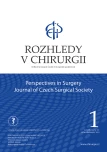Laparoscopic-asisted percutaneus endoscopic cecostomy (LAPEC) in the treatment of severe constipation of adults – single center study
Authors:
R. Husťak 1,2,4; R. Škuta 1; A. Dobrovodský 1; M. Habiňák 1; D. Kudlová 1; A. Janegová 1; E. Plavčanová 1,3; J. Rajec 1,2; J. Martínek 1,4
Authors‘ workplace:
Fakultná nemocnica v Trnave, Trnava
1; Trnavská univerzita v Trnave, Trnava
2; Vysoká škola zdravotníctva a sociálnej práce sv. Alžbety, Bratislava
3; Inštitút klinickej a experimentálnej medicíny, Praha
4
Published in:
Rozhl. Chir., 2022, roč. 101, č. 1, s. 22-27.
Category:
Original articles
doi:
https://doi.org/10.33699/PIS.2022.101.1.22–27
Overview
Introduction: Effective treatment for chronic constipation is a real clinical challenge, especially in patients with severe symptoms. If conservative measures do not help, usually subtotal colectomy with ileorectal anastomosis has been used as the treatment of choice for refractory slow-transit constipation, but consequences may unfavorably affect quality of life. Percutaneous endoscopic caecostomy (PEC) with antegrade colonic enema (ACE) is a minimally invasive alternative to avoid radical surgery in order to improve bowel movement. Recently, of various catheter placement techniques, a laparoscopic-assisted percutaneous endoscopic cecostomy has been applied in clinical praxis.
Methods: We performed retrospective analysis of 5 patients with Chait Trapdoor catheter placed for purpose of ACE by LAPEC. Main outcome was to assess clinical success of PEC defined by an improvement of at least 50% of baseline KESS at 6M. Secondary outcomes were: procedural parameters and safety of procedure.
Results: Since may 2019 to march 2021, LAPEC was performed in 5 patients. Median follow-up was 14 months (7V12). All PECs were placed successfully in cecum. Treatment success reached 60% (3/5) of patients. Postoperative complication occurred in three patients.
Conclusion: LAPEC provides both endoscopic and laparoscopic visualization, thereby, significantly decreasing potential risks by ensuring precise and safe access to the cecum. Antegrade colonic enema through PEC provides improvement of bowel movement in highly selected patient with severe symptoms.
Keywords:
Constipation – laparoscopy – cecostomy – antegrade colonic enema – defecography
Sources
1. McCrea GL, Miaskowski C, Stotts NA, et al. Review article: Self-report measures to evaluate constipation. Alimentary Pharmacology and Therapeutics. Aliment Pharmacol Ther. 2008 Apr;27(8):638−648.. doi: 10.1111/j.1365-2036.2008.03626.x.
2. Lacy BE, Mearin F, Chang L, et al. Bowel disorders. Gastroenterology 2016 Feb 18;S0016-5085(16)00222−5. doi: 10.1053/j.gastro.2016.02.031.
3. Knowles CH, Scott M, Lunniss PJ. Outcome of colectomy for slow transit constipation. Annals of Surgery 1999;627–638. doi: 10.1097/00000658-199911000-00004.
4. Ripetti V, Caputo D, Greco S, et al. Is total colectomy the right choice in intractable slow-transit constipation? Surgery 2006;140:435–440. doi: 10.1016/j. surg.2006.02.009.
5. Kamm MA, Hawley PR, Lennard-Jones JE. Outcome of colectomy for severe idiopathic constipation. Gut 1988;29:969– 973. doi: 10.1136/gut.29.7.969.
6. Knowles CH, Eccersley AJ, Scott SM, et al. Linear discriminant analysis of symptoms in patients with chronic constipation: validation of a new scoring system (KESS). Dis Colon Rectum 2000;43:1419-26. doi: 10.1007/BF02236639.
7. Malone PS, Ransley PG, Kiely EM. Preliminary report: the antegrade continence enema. The Lancet 1990;336:1217–1218. doi: 10.1016/0140-6736(90)92834-5
8. Dey R, Ferguson C, Kenny SE, et al. After the honeymoon-medium-term outcome of antegrade continence enema procedure. J Pediatr Surg. 2003;38:65–68. doi: 10.1053/jpsu.2003.50012.
9. Halleran DR, Vilanova-Sanchez A, Rentea RM, et al. A comparison of Malone appendicostomy and cecostomy for antegrade access as adjuncts to a bowel management program for patients with functional constipation or fecal incontinence. Journal of Pediatric Surgery 2019;54:123– 128. doi: 10.1016/j.jpedsurg.2018.10.008. Epub 2018 Oct 5.
10. Ricard J, Rhun M Le, Chabrun E, et al. 1019 Percutaneous endoscopic caecostomy: feasibility, efficacy and complication rates in refractory colorectal disorders. Gastroenterology 2015;148:S-191. doi: 10.1016/S0016-5085(15)30636-3
11. Rodriguez L, Flores A, Gilchrist BF, et al. Laparoscopic-assisted percutaneous endoscopic cecostomy in children with defecation disorders (with video). Gastrointestinal Endoscopy 2011;73:98–102. doi: 10.1016/j.gie.2010.09.011.
12. Weusten BLAM, Barret M, Bredenoord AJ, et al. Endoscopic management of gastrointestinal motility disorders - part 1: European Society of Gastrointestinal Endoscopy (ESGE) Guideline. Endoscopy 2020;52:498–515. doi: 10.1055/a-1160- 5549.
13. Pfeifer J. Surgical options to treat constipation: A brief overview. Rozhledy v chirurgii 2015;94:349–61.
14. Marker DR, Perosi N, Ul Haq F, et al. Percutaneous cecostomy in adult patients: Safety and quality-of-life results. J Vasc Interv Radiol. 2015 Oct;26(10):1526−1532.e1. doi: 10.1016/ j.jvir.2015.06.014.
15. Poirier M, Abcarian H, Nelson R. Malone antegrade continent enema: An alternative to resection in severe defecation disorders. Dis Colon Rectum. 2007 Jan;50(1):22−28. doi: 10.1007/s10350- 006-0732-x.
16. Rivera MT, Kugathasan S, Berger W, et al. Percutaneous colonoscopic cecostomy for management of chronic constipation in children. Gastrointestinal endoscopy. 2001;53:225–228. doi: 10.1067/ mge.2001.112182.
17. Wedel T, Roblick UJ, Ott V, et al. Oligoneuronal hypoganglionosis in patients with idiopathic slow-transit constipation. Diseases of the Colon & Rectum 2002;45:54–62. doi: 10.1007/s10350- 004-6114-3.
Labels
Surgery Orthopaedics Trauma surgeryArticle was published in
Perspectives in Surgery

2022 Issue 1
Most read in this issue
- High resolution anorectal manometry in patients with anorectal dysfunctions and the therapeutic consequences
- Incarcerated left paraduodenal hernia − case report and literature review
- Successful repeated gastric peroral endoscopic myotomy (re-G-POEM) in the treatment of postsurgical gastroparesis
- Endoscopic management of gastrointestinal motility disorders
